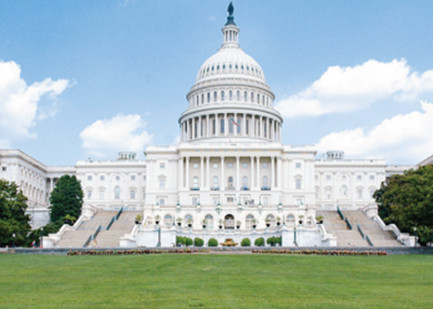




 |
 |
 |
|||
 |
 |
 |
 |
 | |
 |
 |
 | |


| 미디어 브리핑스 | 내서재담기 |


  |
 |  |
2018년 9월 기준 미국에서는 실업보다 더 많은 일자리가 생겨나고 있다. 임금은 인플레이션보다 더 빠르게 상승하고, 소비 및 경제 신뢰지수는 역대 최고를 기록 중이다. 사전 조사된 수치에 따르면, 2018년 미국의 GDP 성장은 전년보다 더 높아질 전망이다. 미국 경제를 전 산업에 걸쳐 상승세로 만든 요인은 무엇인가? 성장 유지나 더 큰 성장을 위해 어떤 정책이 필요한가? 트럼프 행정부의 지난 정책 방향과 향후 정책 비전을 통해 알아보자.
2017년 12월에 통과된 트럼프 세제 개혁안인 ‘세금 감면 및 일자리 법안(Tax Cuts and Jobs Act·TCJA)’과 함께 트럼프 행정부의 방대한 규제 완화 노력은 이미 미국 경제에 큰 영향을 끼치고 있다.
현재 미국 경제는 실업보다 더 많은 일자리를 창출하고 있다. 각종 경제 조사에 따르면, 임금이 상승하고, 소비와 경제 신뢰지수는 더 높아지고 있다. 2018년 2분기 실질 GDP 성장률은 작년 대비 더 높아졌으며, 이 추세를 내년에도 이어질 전망이다.
미국의 소비자들 또한 실질적인 급여 인상, 세금 감면, 일자리 증대 등의 성과로 인해 행정부의 친 성장 정책을 이미 인식하고 있다. 규제 영역에서도 트럼프는 오마바 대통령 시절 제정된 각종 규제를 철폐하는데 공격적이다. 새로운 규정을 최소화하는 데 중점을 두어, 2017년 기준 대다수의 기관은 2016년보다 규제를 획기적으로 줄였다.
현재까지 가장 효과적인 규제 변화는 북미 에너지 혁명과 관련된 것들이었다. 2019년에는 규제가 대부분 바뀌거나 철회되어 대규모 인프라 프로젝트의 길이 더 크게 열릴 전망이다. 더불어 투자수익률이 더욱 확실해지면서 민간 부문 프로젝트들도 더 신속하게 진행될 것으로 보인다. 한편 초당적 의회의 지원을 받는 공공 부문 프로젝트는 불필요한 정부 자산의 매각으로 자금을 조달할 것이다.
이에 그치지 않고 규제 분야에서는 앞으로도 더 많은 철폐가 이뤄질 전망이다. 의회의 개입없이 행정부의 권한으로 진행될 수 있는 것들도 많으며, 트럼프는 행정부의 최종 입장을 지지하는 연방 판사들을 임명하면서 그 과정을 더 빠르게 가속화시킬 계획이다.
한편 세금 정책은 미국을 재산업화하려는 광범위한 계획의 한 구성 요소이다. 2017년 감세의 첫 번째 목표는 비즈니스 영역에 중점을 둔 것으로 자본 투자와 재원 조달을 장려하는 데 있었다. 위스콘신의 거대한 폭스콘(Foxxcon) 공장과 미국 석유 화학 산업에 대한 엄청난 투자는 이 과정을 통해 이뤄졌다.
세금 정책의 다음 단계는 투자 및 저축에 중점을 둔 개인 영역에 있다. 이는 실직 상태에 있거나, 일을 하지 않은 계층, 그리고 대다수의 X세대, 모든 밀레니엄 세대가 기초적인 생활양식을 유지하는 데 필요한 은퇴비용이 부족한 상황에서 특히 중요하다.
뉴트 깅그리치(Newt Gingrich) 전 하원 의장 또한 트럼프 행정부가 규제 완화와 세금 감면을 통해 두 영역에서의 성장에 목표를 두고 있음을 밝히고, 여기에 추가적으로 미국 경제를 더 새롭고 견고한 상태로 만들 수 있는 세 번째 아젠다를 이야기했다.
우리가 강조하고 싶은 점은 바로 이 세 번째에 해당한다. 그것은 바로 혁신이다.
혁신은 민간 부문의 삶을 더 풍요롭게 만들고 정부를 보다 효율적이고 효과적으로 만드는 새로운 돌파구를 찾게 해준다. 이것은 정부를 무작정 축소하자는 논의가 아니라 현재의 구조와 규모를 비용 대비 효율성이 훨씬 더 높아지도록 만드는 것이다.
사실, 현재의 관료 체제는 대량 생산 시대에 맞게 설계된 것이다. 이제 30년이 지나, 이 체제는 디지털 시대의 현대적인 시스템으로 변화시켜야 한다. 디지털 시스템은 반응이 빠르고 더욱 효과적이다.
하나의 사례를 보자. 펜타곤은 1941년에 수동식 타자기, 카본지, 파일 캐비닛으로 전 세계 전쟁을 관리한 약 3만 명의 사람들을 수용하기 위해 문을 열었다. 당시에는 복사기나 팩스 자체가 존재하지 않았다. 하나의 보고서를 작성하려면 그것의 초안을 만드는 그룹, 사본을 만들기 위해 타이핑을 치는 그룹, 사본을 배포하는 그룹, 그리고 그 사본들을 적절한 파일 캐비닛에 파일링하는 그룹을 필요로 했다. 이 원시적인 시스템이 오늘날의 5배가 넘는 병력을 지원했다.
그러나 병력이 20퍼센트로 줄어들고, 수동 타자기, 카본지, 파일 캐비닛 업무가 아이패드(iPads), PC, 광섬유 네트워크로 대체된 이후 얼마나 많은 사람들이 사라졌는가?
오늘날 펜타곤에는 여전히 3만 명이 일하고 있다. 기술은 바뀌었지만 펜타곤 시스템은 혁신적이지 않다. 관료주의로 인해 여전히 1941년의 속도로 움직이고 있는 1941년의 규모를 유지하고 있는 것이다. 비유적으로 말해, 펜타곤은 이제 삼각형으로 바꿀 수 있어야하고 건물의 40퍼센트는 다른 용도로 변경해도 된다. 결과적으로 비용을 대폭 절감하면서 더욱 안전한 국가를 만드는 것, 그리고 반응이 빠른 시스템으로 변화시키는 것이 가능한 것이다. 그것은 혁신에 달려 있다.
헬스 케어 산업은 어떤가?
의료 서비스 제공자들이 전 세계 최고의 비즈니스 모델을 구성할 수 있도록 인센티브를 제공하면, HCCI와 아틀란스MD(AtlasMD)와 같은 조직이 나타나 병원 및 1차 진료비용을 절반으로 줄일 수 있는 혁신을 내놓았다. 이러한 혁신을 지원함으로써 헬스 케어에 드는 기존 비용을 천문학적 수준으로 절감하면서 효율성과 효과성을 크게 높일 수 있다.
이러한 혁신 중 하나인 소위, 가치 기반 의료는 성과에 대한 인센티브를 제공하여, 건강을 보다 비용 효과적으로 개선하고, 모든 의료 시스템에 대한 진화적 해체 및 재구성을 가능하게 하고 있다.
깅그리치 전 하원 의장은 여기에 바이오 의약품에 대한 비전도 언급했다. 새로운 의약품 및 의료 연구를 비용이 많이 드는 것으로 생각하지 말고, 심장병, 암, 당뇨병과 같은 비용이 많이 소요되는 질병을 치료할 때의 경제적 이익에 대한 것이다. 즉, 건강한 사람은 생산적이며, 생산적인 사람들의 부가적인 경제적 가치는 바이오 의약품의 개발과 생산 비용을 초과한다.
1970년부터 2000년까지 관상 동맥 심장 질환 치료는 크게 향상되었다. 결과적으로 1백만 명이 넘는 사람들의 생명을 구했고, 이는 미국 경제에 연간 1.6조 달러의 생산을 더 추가시켰다. 또한 암 사망률을 1퍼센트 감소시킬 때마다 생산성 증가, 치료 비용 감소, 생존자의 저축 활동에 따른 부수적 효과는 5천 억 달러에 이른다. 그래서 암 치료는 최대 50조 달러의 가치를 지니고 있다. 알츠하이머 병은 어떤가? 2025년까지 이 질병의 평균 발병을 5년 지연시키는 치료법을 찾는다면, 2050년까지 연간 치료비를 3,760억 달러로 줄일 수 있다.
오늘날 미국의 혁신 아젠다는 삶을 개선하고 균형 예산으로 향하는 길로 안내하기 때문에 매우 중요하다. 우리는 미 연방 예산의 27퍼센트와 16퍼센트를 차지하는 헬스케어와 국방 비용 사례에 대해서만 이야기한 것이다. 이러한 혁신이 미국의 전체 시스템에 걸쳐 이뤄진다면 그 결과는 우리가 상상하는 그 이상일 것이다.
이러한 미국의 아젠다 ‘혁신’를 고려하여 우리는 향후 다음 3가지를 예측해본다.
첫째, 민주당이 하원의 다수가 되었어도, 트럼프 행정부는 친 성장 규정을 계속 강화할 것이다.
출범 첫해, 트럼프 행정부가 먼저 한 일은 오바마 행정부의 후반기에 이뤄진 규제를 우선 폐기하는 것이었다. 이때 트럼프는 오바마 시대의 각종 규제를 철폐하기 위해 의회와 협력했다. 이후 2018년 트럼프 행정부는 그들의 규정을 새로 발표하기 시작했다. 이 중 일부는 분명 사법부의 도전을 받게 될 것이다. 그러나 트럼프가 보수적 성향의 판사를 법원에 합류시키면서 이러한 도전은 약화될 수 있다. 각종 규제가 폐지되고, 새로운 친 성장 규정이 가속화되면서 미국 경제는 현 성장세를 당분간 계속 이어갈 것으로 보인다.
둘째, 규제 철폐 이후 트럼프의 다음 경제 정책 단계는 2020년 회계 연도부터 자본소득(capital gain)을 세금 지수에 연동시키는 방향이 될 것이다.
이 대담한 조치는 경제 성장을 더욱 가속화하고 자본을 더 자유롭게 하며 투자를 늘리고 미국 경제에 투자하는 이들에 대한 보상으로 이어질 것이다. 명제는 아주 간단하다. 인플레이션으로 인해 실질 가치가 없는 경우에도 명목 가치는 상승한다. 따라서 실제 가치가 하락한 경우에도 투자에 대한 세금을 납부할 수 있다.
재무부 경제학자로 활동했던 게리 로빈스(Gary Robbins)는 인플레이션에 대한 자본소득을 연동시키면 2025년까지 40만 개의 일자리가 창출되고, 미국의 자본금은 1조 1천 억 달러로 늘어나며, 연간 GDP가 약 5천 억 달러로 커질 것이라고 예측했다. 이 모든 것을 가구로 나누면 가구당 평균 3,600달러에 해당한다.
경제법 전문가들은 “오늘날의 재무부는 인플레이션에 기인한 ‘이익’이 납세자의 실제 재산이나 구매력에 아무런 영향을 미치지 않는다는 경제적 현실을 고려하여 ‘비용’을 재해석할 수 있는 행정 재량권을 가지고 있다”고 믿고 있다. 트럼프 행정부 기간, 앞으로 ‘비용’이라는 용어는 하나 이상의 합리적인 해석의 적용을 받을 것이고, 인플레이션을 감안하는 방향으로 적용될 수 있다. 또한 미국의 내국세법(Internal Revenue Code)은 자산의 ‘비용’이 단지 명시된 숫자로만 측정되어야 한다고 요구하지 않고 있다.
셋째, 행정부 혁신 프로그램의 주요 구성 요소에는 해리 S. 트루먼(Harry S. Truman) 대통령 이후 처음으로 시작될 ‘조직 재구성’과 ‘축소’가 포함할 것이다.
현재의 혁신은 조직의 효율성 확대에 집중되어 있다. 믹 멀베이니(Mick Mulvaney) 백악관 예산국장은 2016년 선거 이후 이러한 대담하고 큰 조치를 함께 해오고 있다. 정부 산하 실무 조직을 재구성하려는 이러한 계획이 성공한다면 믿을 수 없을 만큼 확실한 긍정적 결과를 가져올 것이다. 그 결과는 수십 년에 걸쳐 경제적 배당을 미국 경제에 쏟아내기 시작할 것이다.
* *
References List :
1. Fox News. June 22, 2018. Newt Gingrich. Beginning the Innovation Agenda.
http://www.gingrichproductions.com/2018/06/beginning-the-innovation-agenda/
2. Fox News. August 8, 2018. Newt Gingrich. Index Capital Gains Taxes Now.
http://www.gingrichproductions.com/2018/08/index-capital-gains-taxes-now/
3. Brookings Institution. June 29, 2018. Connor Raso. Where and why has agency rulemaking declined under Trump.
https://www.brookings.edu/research/where-and-why-has-agency-rulemaking-declined-under-trump/
 |  |
America’s Growth Agenda
The Trump administration’s massive deregulation effort coupled with enactment of the Tax Cuts and Jobs Act passed in December 2017, has already done wonders for the U.S. economy.
As highlighted in this issue’s trend #3, there are now more open jobs than there are “unemployed” people. Wages are increasing, and consumer and business confidence is rising with them. Preliminary estimates show real second quarter GDP growth to be 4.2 percent and the Trends editors predict it will be revised higher.
As highlighted in our July 2018 issue, Americans are already recognizing the benefits of the administration’s pro-growth agenda as represented by bigger paychecks, lower taxes and more opportunities.
In the area of deregulation, the Trump administration has been particularly aggressive in halting costly Obama-era regulations that were in the pipeline as of January 2017. And it has also been focused on minimizing the number of new regulations it creates. For instance, in 2017, most agencies issued dramatically fewer regulations than in 2016.
To-date the most effective regulatory shifts have been those associated with the North American Energy Revolution. In 2019, regulatory changes will pave the way for massive infrastructure projects. Private sector projects will move ahead as the ROI becomes more certain. Meanwhile public sector projects with bipartisan Congressional support will move ahead funded by the sale of superfluous government assets.
In the regulatory sphere, a great deal can be done without involvement from Congress. So, as the administration fills the final positions in the executive branch and appoints more growth-friendly Federal judges, this process will accelerate. Most likely these executive and judicial appointment will become easier in 2019, as the partisan make-up of the Senate becomes increasingly conservative.
Tax policy is just one component of a broader plan to reindustrialize the United States. That’s why the first round of tax cuts in 2017, was aimed primarily at business. The primary objective was encouraging capital investment and reshoring. We can already see how this has paid off in the form of the huge Foxxcon plant in Wisconsin and the enormous investments made in the U. S. petrochemical industry.
The next phase of “tax relief” will focus more on the individual, with emphasis on investment and saving. This is particularly important when you consider that many Boomers, most Xers, and all-but-a-few Millennials lack the level of retirement savings needed to maintain a reasonable lifestyle.
Former Speaker of the House, Newt Gingrich, confirms that the administration sees deregulation and tax relief as two legs supporting a pro-growth agenda. However, he argues that a third leg is coming which will make the new American economy “rock solid.”
That third pillar is economic innovation, which will enable the private sector to find new breakthroughs which will make our lives better and make government itself more efficient and effective. That means that we’re no longer simply talking about making government smaller; we’re talking about making it highly cost-effective.
The bureaucratic systems we have across the public sector were designed for the Mass Production era. Over the past 30+ years, their de facto mission has been to grow and perpetuate themselves. Shrinking the current systems would only render them underfunded and ineffective. Instead, the objective is to replace them with modern systems for the Digital Era, which are lean, responsive and effective.
Consider one particularly egregious example. The Pentagon opened in 1941 to house nearly 30,000 people who managed a global war with manual typewriters, carbon paper and filing cabinets. There were no copiers or fax machines. Generating a single report required a group of people to draft it, a group to type copies, a group to distribute the copies, and a group of people to file them in the appropriate filing cabinets. And that primitive system supported a fighting force that was over 5-times the size it is today.
Now, consider how many people a private business would cut out when it shrank by 80% and replaced manual typewriters, carbon paper, and filing cabinets with iPads, personal computers, and fiber-optic networks. Yet, there are still nearly 30,000 people working in the Pentagon, today.
The technology has changed, but the Pentagon system has not innovated. The bureaucracy is still the 1941 size, moving at the 1941 pace. Figuratively speaking, we should be able to turn the Pentagon into a triangle, and (at a minimum) 40 percent of the building should be turned into a national defense museum. The result would be a leaner, more responsive defense apparatus that would make Americans safer at a dramatically lower cost to taxpayers.
As highlighted in the August 2018 issue, health care could also greatly improve the lives of Americans while saving a tremendous amount of money, by supporting innovations in health care practices and business models. This means creating incentives for healthcare providers to adopt “best-of breed” business models from around the world. Organizations like HCCI and AtlasMD, demonstrate that the cost of hospitals and primary care practices could be cut in half, if world-class “best practices” were adopted!
One initiative under consideration, would enable value-based contracting for government and private health-care providers. Other policies would mandate incentives toward good outcomes, better health, and lower costs, and truly standardized electronic medical records across all health systems.
Speaker Gingrish, cites another opportunity in changing the way we think of bio-pharmaceuticals. Instead of thinking of new medicines and medical research as being costly, we need to think about the economic benefit of curing expensive illnesses, like heart disease, cancer, and diabetes.
Why? Simply put, healthy people are more productive and the added economic value of these productive people will pay for the cost of developing and producing these drugs. Consider just three examples:
1. From 1970 to 2000, treatment for coronary heart disease greatly improved. As a result, more than 1 million peoples’ lives were saved, and they have added $1.6 trillion per year to our economy. This means that the additional economic output generated from coronary heart disease treatment improvements alone is roughly 40% as big as total (public and private) health-care spending in the United States.
2. Every time we decrease cancer mortality by 1 percent, it amounts to $500 billion in increased productivity, decreased treatment costs and other savings. So, curing cancer could be worth up to $50 trillion. And,
3. Alzheimer’s disease will be one of our most expensive challenges, going forward. If, by 2025, we were able to find treatments that would simply delay the average onset of the disease by five years, we would reduce the annual cost of treating it by $376 billion by 2050. The good news is that, as of mid-2018, there were 105 new Alzheimer’s drugs currently in testing.
The administration’s “innovation agenda” is important because it will make life better for Americans and it will also provide a path toward a balanced budget.
We have only highlighted examples in health care and national defense because they make up 27 and 16 percent of the federal budget, respectively. Yet, there are many other opportunities to streamline, innovate and improve across the entire federal system.
Given this trend, we offer the following forecasts for your consideration.
First, over the next two years, the administration will ramp up issuance of pro-growth regulations, particularly if it loses control of the House of Representatives.
In its first year, the current administration shelved unissued regulations developed in the latter portion of the Obama administration. It also worked with Congress to withdraw numerous Obama-era regulations. Then, in 2018, the Trump administration began issuing new regulations of its own. Some of these will certainly be challenged in court, but as more conservative judges join the courts, these regulations are more likely to stand up under judicial review. By 2021, the Trends editors expect the $2+ trillion in annual regulatory compliance costs to fall rapidly, further boosting economic growth.
Second, the next big step in President Trump’s economic revolution will be to index the capital gains tax, beginning in fiscal year 2020.
This bold step will dramatically accelerate economic growth, liberate capital, boost investment, and reward those who have had faith in investing in the American economy. The proposition is quite simple. With inflation, nominal values go up even if real values don’t. As a result, you can owe taxes on your investments ? even when their real value has declined. Former Treasury economist Gary Robbins estimates that starting to index capital gains for inflation, this year, would, by 2025, create an additional 400,000 jobs, grow the U.S. capital stock by $1.1 trillion and boost annual GDP by roughly $500 billion. That all translates to an additional $3,600 for the average household. And fortunately, experts “believe that the Treasury has administrative discretion to reinterpret ‘cost’ to take into account the economic reality that a ‘gain’ attributable solely to inflation adds nothing to the taxpayers real wealth or purchasing power. The term ‘cost’ is subject to more than one reasonable interpretation and is readily amenable to a construction that takes account of inflation. Furthermore, “the Internal Revenue Code does not require that the ‘cost’ of an asset be measured only as its original price, meaning there is no reason Treasury could not construe it in today’s dollars. And,
Third, a major component of the administration’s innovation program will involve the first wholesale reorganization and downsizing of the executive branch since the presidency of Harry S. Truman.
Mick Mulvaney, Director of the Office of Management and Budget has been working on this earth-shattering proposal since the 2016 election. From what we can tell this plan to reorganize the executive branch is incredibly promising and a successful transition will pay economic dividends for decades to come.
References
1. Fox News. June 22, 2018. Newt Gingrich. Beginning the Innovation Agenda.
http://www.gingrichproductions.com/2018/06/beginning-the-innovation-agenda/
2. Fox News. August 8, 2018. Newt Gingrich. Index Capital Gains Taxes Now.
http://www.gingrichproductions.com/2018/08/index-capital-gains-taxes-now/
3. Brookings Institution. June 29, 2018. Connor Raso. Where and why has agency rulemaking declined under Trump.
https://www.brookings.edu/research/where-and-why-has-agency-rulemaking-declined-under-trump/
